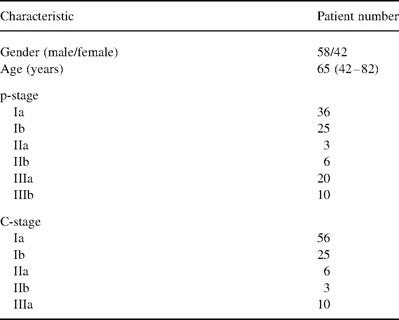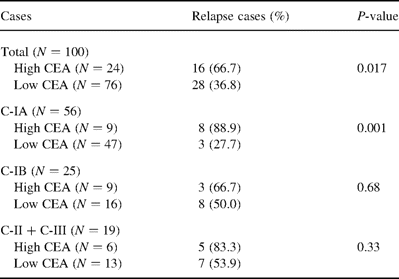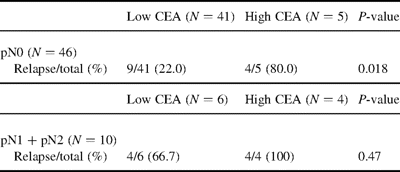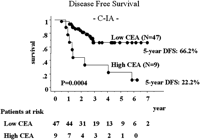-
PDF
- Split View
-
Views
-
Cite
Cite
Yukinori Sakao, Shinji Tomimitsu, Yuji Takeda, Masafumi Natsuaki, Tsuyoshi Itoh, Carcinoembryonic antigen as a predictive factor for postoperative tumor relapse in early-stage lung adenocarcinoma, European Journal of Cardio-Thoracic Surgery, Volume 25, Issue 4, April 2004, Pages 520–522, https://doi.org/10.1016/j.ejcts.2004.01.029
Close - Share Icon Share
Abstract
Objectives: To clarify the usefulness of measuring serum carcinoembryonic antigen (CEA) preoperatively to detect patients who will have a poor outcome after surgery, and who cannot be selected by conventional staging modalities. Methods: One hundred patients with adenocarcinoma of the lung underwent standard surgical procedures between 1994 and April 2001 at our institution. Preoperative staging was assessed according to the TNM classification of the International Union Against Cancer. The associations between preoperative serum CEA level and the postoperative recurrence or lymph node metastasis were examined. The serum CEA level was classified into two groups according to concentration of CEA level: low (normal) CEA (≤5.0 ng/ml) and high CEA (>5.0 ng/ml). Results: The high CEA level was associated with tumor relapse (P=0.01). According to the preoperative staging, the increased CEA was associated with tumor relapse only in stage C-IA (P=0.001). Stage C-IB and more advanced stages did not show an association between increased CEA and tumor relapse. In C-IA, risk for lymph node involvement was significantly higher in the high CEA group (4/9; 44.4%) than in the low CEA group (6/47; 12.8%, P=0.03). Furthermore, the rate of tumor relapse in C-IA-pN0 was significantly higher in the high CEA group (4 of the 5, 80%) than in the low CEA group (9 of the 41, 22.0%, P=0.018). The 5-year disease-free survival rate for patients with a high serum CEA level (N=9) was 22.2%, and 75.0% for patients with a normal CEA (N=47) level (P=0.0004). Conclusions: Increased serum CEA is an important predictive factor for poor outcome after surgery in early-stage (C-IA) lung adenocarcinoma.
1 Introduction
Carcinoembryonic antigen (CEA) is one of the most popular tumor markers measured in lung cancer, and its various clinical applications have been reported [1–3]. Recently, several reports have indicated that increased preoperative CEA levels are associated with a poor outcome after surgery [3–6]. In other words, preoperative measurement of serum CEA may give additional useful prognostic data, which cannot be measured by conventional staging modalities (chest computed tomography (CT), abdominal CT or ultrasonography, brain CT or magnetic resonance imaging and bone scanning), to select the best therapeutic plan. In this retrospective study, we have tried to clarify the usefulness of preoperative serum CEA measurement to identify patients who are likely to have a poor outcome after surgery, and who may be candidates for preoperative or postoperative multimodal therapy.
2 Materials and methods
Between 1994 and April 2001, 392 patients underwent surgical resection of primary lung cancer within our department. Among these, 100 patients with adenocarcinoma of the lung underwent standard surgical procedures (lobectomy+hilar and mediastinal node dissection without induction therapy), and were available for preoperative serum CEA. The group comprised of 58 males and 42 females, with ages ranging from 42 to 82 years (median age 65 years). Preoperative staging was assessed according to the TNM classification of the International Union Against Cancer [7] using chest CT, abdominal CT or ultrasonography, brain CT or magnetic resonance imaging and bone scanning for all patients. Clinical mediastinal and hilar lymph node status was assessed as positive if the results of the chest CT showed that the shorter axis was larger than 1.0 cm. The associations between preoperative serum CEA level and the postoperative recurrence or lymph node metastasis were examined. The serum CEA level was calculated using an enzyme-linked immunosorbent assay (ELISA) kit with the upper limit of normal as 5 ng/ml in our institute based on the 95% specificity level for benign lung disease. Patients were classified into two groups according to the concentration of CEA: low (normal) CEA (≤5.0 ng/ml) and high CEA (> 5.0 ng/ml). A complete systemic evaluation including the same tests performed at diagnosis was scheduled for all subjects every 6 months after the surgery. Recurrence was defined as any unequivocal occurrence of new cancer foci in a disease-free patient. The follow-up period ranged from 24 to 102 months (median 52 months) (Table 1) .

2.1 Statistical analysis
The disease-free survival rates were calculated using the Kaplan–Meier method. Analyses between two groups were performed using the log-rank test or Fisher's exact test in Stat View J 5.0 (SAS Institute Inc, Cary, NC), and P-value of 0.05 was accepted as significant.
3 Results
3.1 CEA and relapse
The CEA concentration was significantly higher in the relapse group (N=44; mean 7.0±9.2 ng/ml) than in the non-relapse group (N=56; mean 3.8±5.8 ng/ml; P=0.045). To evaluate CEA concentration as a preoperative predictive factor for tumor relapse after surgery, we analyzed the association between CEA concentration and tumor relapse according to preoperative staging (clinical stage) (Table 2) . The high CEA was associated with tumor relapse (P=0.017). According to the preoperative staging, the CEA was associated with tumor relapse only in stage C-IA (P=0.001). C-IB and more advanced stages did not show an association between CEA concentration and tumor relapse.

3.2 Lymph node involvement and relapse according to CEA concentration in C-IA
In C-IA, the risk of lymph node involvement was significantly higher in the high CEA group (4/9; 44.4%) than in the low CEA group (6/47; 12.8%; P=0.03). Furthermore, the rate of tumor relapse in stage C-IA-pN0 was significantly higher in the high CEA group (4 of the 5; 80%) than in the low CEA group (9 of the 41; 22.0%; P=0.018) (Table 3) . The disease-free survival rates according to CEA concentration of C-IA lung adenocarcinoma patients are shown in Fig. 1 . The 5-year disease-free survival rate for the patients with high serum CEA level (N=9) was 22.2%, and 75.0% for the patients with a normal CEA (N=47) level (P=0.0004).

Lymph node status and tumor relapse according to CEA concentration in C-IA

Disease-free survival rate in C-IA adenocarcinoma according to preoperative serum CEA concentration. Low CEA, preoperative serum CEA concentration ≤5.0 ng/ml. High CEA, preoperative serum CEA concentration >5.0 ng/ml. CEA, carcinoenbryonic antigen. DFS, disease-free survival.
4 Discussion
In this study, we reveal that a preoperative high CEA concentration was a predictive factor for tumor relapse after surgery. The increased serum CEA before surgery was associated with postoperative tumor relapse, especially in C-IA lung adenocarcinoma according to the clinical stage. The 5-year disease-free survival rate for patients with a high serum CEA level was 22.2%, and 75.0% for patients with a normal CEA level (P=0.0004) in C-IA lung adenocarcinoma. Similarly Sawabata et al. [5] have reported that serum CEA level is a useful predictor for survival in clinical I lung cancer. However, in the present study, a high serum CEA is not a predictor for survival in C-IB but a predictor in C-IA. Furthermore, high CEA patients showed a higher incidence of lymph node metastases than did low CEA patients (44.4 versus 12.8%, P=0.03) in C-IA. However, the relapse rate was significantly higher in high CEA patients than in low CEA patients (80.0 versus 22.0%, P=0.018), even if they were assessed as C-IA-pN0. Thus, a preoperative increased serum CEA level is a risk factor for not only lymph node metastasis but also for relapse independent of lymph node metastasis in C-IA lung adenocarcinoma. Although the patients who had an increased serum CEA concentration comprised less than 20% (10 of 56) of the patients in C-IA, these patients should be treated with a therapeutic strategy for advanced-stage patients (i.e. neoadjuvant chemotherapy or postoperative chemotherapy). It is still suggested that preoperative increased serum CEA concentration has an adjunctive role in the staging of lung cancer [3–6].
In summary, an increased serum CEA level is an important predictive factor for poor outcome after surgery in C-IA adenocarcinoma of the lung. It is suggested that we should consider new strategies for therapy, such as pre and/or postoperative chemotherapy, for patients who have increased serum CEA concentrations, even if they are diagnosed as C-T1N0M0-IA.
We thank Dr Edmund J Miller, Chief, Surgical Immunology, North Shore University Hospital, for his critical reviews.




